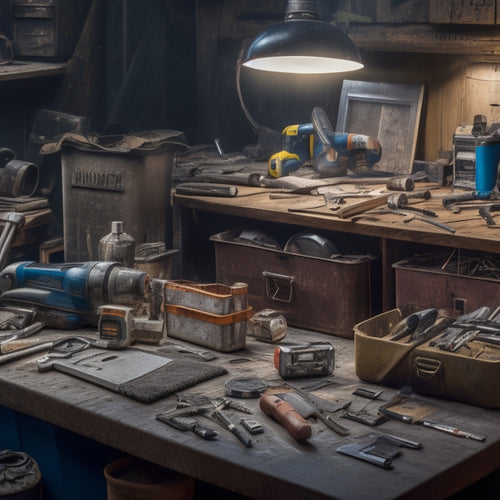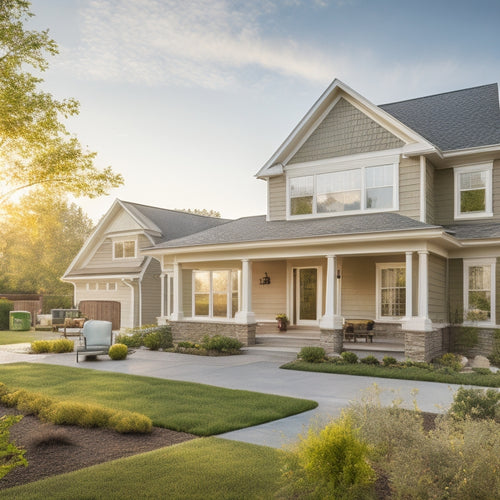
3 Best Paving Options for Your Home Renovation
Share
When renovating your home, you're likely considering the best paving options to elevate your outdoor space. You'll want to weigh the benefits of natural stone paving, which brings sophistication and elegance with its unique texture and pattern. Porcelain paving offers durability and customization options, while concrete paving provides an affordable solution with endless design possibilities. Each option has its strengths, but by exploring their unique advantages, you'll uncover the perfect fit for your home's aesthetic and functional needs, and discover how to create an outdoor space that's both beautiful and functional.
Key Takeaways
• Natural stone paving offers elegance and sophistication, with unique textures and patterns, and is an eco-friendly choice with low environmental impact.
• Porcelain paving is highly durable, resistant to scratches and stains, and ideal for poolside or water feature areas due to its impermeable nature.
• Concrete paving is a cost-effective solution, offering endless design possibilities, and is suitable for various designs, but requires regular cleaning and sealing.
• Each paving option has its unique benefits, and choosing the right one depends on your personal style, budget, and outdoor space requirements.
• Proper maintenance is crucial to ensure the longevity of your chosen paving option, regardless of whether it's natural stone, porcelain, or concrete.
Natural Stone Paving Benefits
Installing natural stone paving instantly elevates your outdoor space, bringing a touch of sophistication and elegance to your home renovation.
As you step out into your newly transformed area, you'll notice the unique texture and pattern of the natural stone, which adds an unparalleled level of aesthetic appeal. The irregularities and variations in color create a sense of authenticity, making your outdoor space feel more organic and connected to nature.
Furthermore, natural stone paving has a relatively low environmental impact compared to other materials. Since it's a natural resource, it requires minimal processing and can be sourced locally, reducing transportation emissions.
Additionally, natural stone is durable and can last for decades with proper maintenance, reducing the need for frequent replacements. When you choose natural stone paving, you're not only enhancing your home's visual appeal but also making an eco-friendly decision that benefits the environment.
Porcelain Paving for Durability
Your pursuit of a highly durable paving option leads you to contemplate porcelain, a material that boasts an impressive resistance to scratches, fading, and stains, making it an ideal choice for high-traffic areas and busy outdoor spaces.
Porcelain pavers are also remarkably resistant to extreme weather conditions, ensuring your outdoor space remains unaffected by rain, snow, or intense sunlight.
Aesthetically, porcelain pavers offer a wide range of styles and colors, allowing you to achieve a unique and sophisticated look that complements your home's exterior.
The porcelain aesthetics will remain intact for years to come, thanks to its low-maintenance requirements. In fact, porcelain maintenance is incredibly straightforward, involving only occasional cleaning with mild detergent and water to maintain its appearance.
Additionally, porcelain pavers are impermeable, making them an excellent choice for areas surrounding pools or water features.
With its unparalleled durability and ease of maintenance, porcelain paving is an excellent option for homeowners seeking a hassle-free outdoor space that exudes style and sophistication.
Concrete Paving for Affordability
Considering your budget constraints, concrete paving emerges as a cost-effective solution, offering a durable and versatile option for your outdoor space renovation. With its affordability, concrete paving becomes an attractive choice for homeowners looking to revamp their outdoor areas without breaking the bank. Not only does it provide a sturdy surface, but it also allows for endless design possibilities, from modern to traditional, to suit your personal style.
| Concrete Paving Benefits | Maintenance Considerations |
|---|---|
| Cost-effective solution | Regular cleaning to prevent stains |
| Durable and long-lasting | Sealing every 2-3 years to maintain appearance |
| Versatile design options | Joint maintenance to prevent weed growth |
When it comes to maintenance, concrete paving requires regular cleaning to prevent stains and occasional sealing to maintain its appearance. Additionally, joint maintenance is essential to prevent weed growth. Despite these considerations, concrete paving remains a popular choice for its affordability and durability. By weighing the benefits against the maintenance requirements, you can make an informed decision about whether concrete paving is the right choice for your outdoor space renovation.
Frequently Asked Questions
Can I Install Paving Over Existing Concrete or Asphalt?
You're wondering if you can install paving over existing concrete or asphalt? The answer is yes, but it's essential to prepare the surface properly.
Make certain the underlying layer is stable, clean, and dry.
Then, apply a bonding agent to create a strong bond between the old surface and new paving materials.
Choose the right installation techniques, such as overlaying or resurfacing, to achieve a seamless look.
How Do I Prevent Weeds From Growing Between Pavers?
You envision a pristine paver patio, but instead, weeds sprout between the cracks, ruining the aesthetic. To prevent this, you'll need to take proactive measures.
Start by laying down a weed barrier, a porous material that blocks weeds while allowing water to pass through.
Next, seal your pavers with a professional-grade sealant to fill gaps and prevent weed growth.
Regularly cleaning and inspecting your pavers will also help prevent weeds from taking hold.
Are There Any Paving Options Suitable for High-Traffic Areas?
When selecting pavers for high-traffic areas, you'll want to prioritize durability.
Compare different surface materials, like porcelain, natural stone, and concrete, to determine which can withstand heavy foot traffic.
Porcelain pavers, for instance, are highly resistant to scratches and fading, making them an excellent choice.
Natural stone pavers, on the other hand, may require more maintenance but offer a unique aesthetic.
Can I Pave a Slope or Uneven Terrain?
When paving a slope or uneven terrain, you'll need to take into account slope stabilization techniques to prevent erosion and guarantee structural integrity.
Start by evaluating the terrain's gradient, then choose a suitable paver material, such as permeable pavers or concrete, that can withstand the forces of gravity.
Don't forget to incorporate drainage solutions, like French drains or retaining walls, to direct water flow and prevent accumulation.
Do Pavers Require Regular Maintenance and Upkeep?
You're probably thinking you'll be stuck with a never-ending to-do list once you've installed those beautiful pavers. Luckily, that's not the case!
While pavers do require regular maintenance, it's not a daily chore. Depending on the paver materials you've chosen, you'll need to perform tasks like cleaning, sealing, and weeding every 3-6 months.
The frequency of maintenance will vary, but with a solid routine, you'll be able to enjoy your outdoor space without worrying about constant upkeep.
Conclusion
You've weighed the pros and cons of each option, and now it's time to make a decision.
Imagine natural stone paving, its earthy tones and organic texture blending seamlessly with your home's exterior.
Picture porcelain paving, its sleek, modern aesthetic radiating sophistication and refinement.
Envision concrete paving, its clean lines and minimalist charm creating a sense of simplicity and functionality.
Whichever path you choose, your home renovation will be transformed, elevated, and forever changed.
Related Posts
-

Why Invest in Quality Plastering Tools for Renovation
When renovating, investing in quality plastering tools is essential for achieving professional-looking results and mi...
-

Smart Guide to Buying Second-Hand Renovation Tools
When buying second-hand renovation tools, you'll want to set clear renovation goals and a realistic budget to priorit...
-

Streamline Your Exterior Renovation Timeline
To streamline your exterior renovation timeline, you'll need to approach the process strategically. Start by planning...


